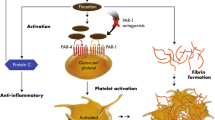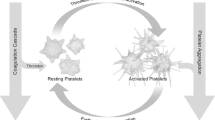Abstract
Coronary artery plaque rupture results in platelet adhesion and activation, the release of adenosine diphosphate (ADP), thromboxane A2, and the generation of thrombin. These factors propagate further platelet activation through a positive feedback mechanism, resulting in the formation of a platelet plug. The treatment of patients with ACS is centered upon the prompt initiation of both antiplatelet and anticoagulant agents. The widespread use of antiplatelet and anticoagulant agents has resulted in a significant reduction in morbidity and mortality but has also increased the risk for bleeding complications. Female gender, advanced age, low body mass index (BMI), low creatinine clearance, and the use of percutaneous coronary intervention have been consistently shown to be risk factors for bleeding. While bleeding was thought to be a necessary side effect and of little clinical significance in the past, it is now clear that bleeding is an independent predictor of adverse ischemic events and mortality. The mechanisms underlying this relationship are not yet fully elucidated and are likely multifactorial (direct effects of bleeding, increased incidence of blood transfusions, less use of antiplatelet agents in both the short and long term). Current treatment guidelines for the use of antithrombotic therapy recommend utilization of evidence-based therapies using clinical strategies shown to minimize the risk of bleeding should when possible. Novel therapies that minimize bleeding risk while providing protection against thrombotic events are needed and may improve outcomes among patients with ACS.
Condensed Abstract
Multiple platelet activation pathways and the coagulation cascade regulate hemostasis and thrombosis. Current antiplatelet and anticoagulant therapies for acute coronary syndromes (ACS) act on distinct sites in the pathways for platelet activation and coagulation. While these therapies are effective in reducing the morbidity and mortality associated with ACS, they are associated with a clinically significant increase in the risk of bleeding events. Novel therapies that minimize bleeding risk while providing protection against thrombotic events may improve outcomes in patients with ACS.


Similar content being viewed by others
References
Antman EM, Anbe DT, Armstrong PW et al (2004) ACC/AHA guidelines for the management of patients with ST-elevation myocardial infarction: a report of the American College of Cardiology/American Heart Association Task Force on Practice Guidelines (Committee to Revise the 1999 Guidelines for the Management of Patients with Acute Myocardial Infarction)
Anderson JL et al (2007) ACC/AHA 2007 guidelines for the management of patients with unstable angina/non ST-elevation myocardial infarction: a report of the American College of Cardiology/American Heart Association Task Force on Practice Guidelines (Writing Committee to Revise the 2002 Guidelines for the Management of Patients with Unstable Angina/Non ST-Elevation Myocardial Infarction) Developed in Collaboration with the American College of Emergency Physicians, the Society for Cardiovascular Angiography and Interventions, and the Society of Thoracic Surgeons Endorsed by the American Association of Cardiovascular and Pulmonary Rehabilitation and the Society for Academic Emergency Medicine. J Am Coll Cardiol 50(7):e1–e157
Smith SC Jr (2006) AHA/ACC guidelines for secondary prevention for patients with coronary and other atherosclerotic vascular disease: 2006 update endorsed by the National Heart, Lung, and Blood Institute. J Am Coll Cardiol 47(10):2130–2139
Cavender MA, Rao SV, Ohman EM (2008) Major bleeding: management and risk reduction in acute coronary syndromes. Expert Opin Pharmacother 9(11):1869–1883
Fauci AS (2008) Harrison’s principles of internal medicine, 17th edn. McGraw-Hill Medical, New York, 2 vols, xxxvii, 2754 p, 149 p
Guyton AC, Hall JE (2006) Textbook of medical physiology, 11th edn. Elsevier Saunders, Philadelphia, xxxv, 1116 p
Abbracchio MP et al (2006) International Union of Pharmacology LVIII: update on the P2Y G protein-coupled nucleotide receptors: from molecular mechanisms and pathophysiology to therapy. Pharmacol Rev 58(3):281–341
Mann KG (2003) Thrombin formation. Chest 124(3 Suppl):4S–10S
Coughlin SR (2005) Protease-activated receptors in hemostasis, thrombosis and vascular biology. J Thromb Haemost 3(8):1800–1814
Moscucci M et al (2003) Predictors of major bleeding in acute coronary syndromes: the Global Registry of Acute Coronary Events (GRACE). Eur Heart J 24(20):1815–1823
Eikelboom JW et al (2006) Adverse impact of bleeding on prognosis in patients with acute coronary syndromes. Circulation 114(8):774–782
Yang X et al (2005) The implications of blood transfusions for patients with non-ST-segment elevation acute coronary syndromes: results from the CRUSADE National Quality Improvement Initiative. J Am Coll Cardiol 46(8):1490–1495
Feit F et al (2007) Predictors and impact of major hemorrhage on mortality following percutaneous coronary intervention from the REPLACE-2 trial. Am J Cardiol 100(9):1364–1369
Kinnaird TD et al (2003) Incidence, predictors, and prognostic implications of bleeding and blood transfusion following percutaneous coronary interventions. Am J Cardiol 92(8):930–935
Kirtane AJ et al (2006) Correlates of bleeding events among moderate- to high-risk patients undergoing percutaneous coronary intervention and treated with eptifibatide: observations from the PROTECT-TIMI-30 trial. J Am Coll Cardiol 47(12):2374–2379
Subherwal S et al (2009) Baseline risk of major bleeding in non-ST-segment-elevation myocardial infarction: the CRUSADE (Can Rapid risk stratification of Unstable angina patients Suppress ADverse outcomes with Early implementation of the ACC/AHA Guidelines) Bleeding Score. Circulation 119(14):1873–1882
Anand SS et al (2003) Relationship of activated partial thromboplastin time to coronary events and bleeding in patients with acute coronary syndromes who receive heparin. Circulation 107(23):2884–2888
Ferguson JJ et al (2004) Enoxaparin vs. unfractionated heparin in high-risk patients with non-ST-segment elevation acute coronary syndromes managed with an intended early invasive strategy: primary results of the SYNERGY randomized trial. JAMA 292(1):45–54
Stone GW et al (2006) Bivalirudin for patients with acute coronary syndromes. N Engl J Med 355(21):2203–2216
Stone GW et al (2008) Bivalirudin during primary PCI in acute myocardial infarction. N Engl J Med 358(21):2218–2230
Randomised trial of intravenous streptokinase, oral aspirin, both, or neither among 17,187 cases of suspected acute myocardial infarction: ISIS-2. ISIS-2 (Second International Study of Infarct Survival) Collaborative Group. Lancet 2(8607):349–360 (1988)
Kushner FG et al (2009) focused updates: ACC/AHA guidelines for the management of patients with ST-elevation myocardial infarction (updating the 2004 guideline and 2007 focused update) and ACC/AHA/SCAI guidelines on percutaneous coronary intervention (updating the 2005 guideline and 2007 focused update) a report of the American College of Cardiology Foundation/American Heart Association Task Force on Practice Guidelines. J Am Coll Cardiol 54(23):2205–2241
Yusuf S et al (2001) Effects of clopidogrel in addition to aspirin in patients with acute coronary syndromes without ST-segment elevation. N Engl J Med 345(7):494–502
Fox KA et al (2004) Benefits and risks of the combination of clopidogrel and aspirin in patients undergoing surgical revascularization for non-ST-elevation acute coronary syndrome: the Clopidogrel in Unstable angina to prevent Recurrent ischemic Events (CURE) trial. Circulation 110(10):1202–1208
Bhatt DL (2007) Intensifying platelet inhibition—navigating between Scylla and Charybdis. N Engl J Med 357(20):2078–2081
Wiviott SD et al (2007) Prasugrel versus clopidogrel in patients with acute coronary syndromes. N Engl J Med 357(20):2001–2015
Novel dosing regimen of eptifibatide in planned coronary stent implantation (ESPRIT): a randomised, placebo-controlled trial. Lancet 356(9247):2037–2044 (2000)
Inhibition of platelet glycoprotein IIb/IIIa with eptifibatide in patients with acute coronary syndromes. The PURSUIT Trial Investigators. Platelet Glycoprotein IIb/IIIa in Unstable Angina: Receptor Suppression Using Integrilin Therapy. N Engl J Med 339(7):436–443 (1998)
Collaborative meta-analysis of randomised trials of antiplatelet therapy for prevention of death, myocardial infarction, and stroke in high risk patients. BMJ 324(7329):71–86 (2002)
Derry S, Loke YK (2000) Risk of gastrointestinal haemorrhage with long term use of aspirin: meta-analysis. BMJ 321(7270):1183–1187
Peters RJ et al (2003) Effects of aspirin dose when used alone or in combination with clopidogrel in patients with acute coronary syndromes: observations from the Clopidogrel in Unstable angina to prevent Recurrent Events (CURE) study. Circulation 108(14):1682–1687
Rao SV et al (2007) Bleeding and blood transfusion issues in patients with non-ST-segment elevation acute coronary syndromes. Eur Heart J 28(10):1193–1204
Rao SV et al (2005) Impact of bleeding severity on clinical outcomes among patients with acute coronary syndromes. Am J Cardiol 96(9):1200–1206
Tolleson TR et al (2003) Relationship between heparin anticoagulation and clinical outcomes in coronary stent intervention: observations from the ESPRIT trial. J Am Coll Cardiol 41(3):386–393
Lassen MR et al (2002) Postoperative fondaparinux versus preoperative enoxaparin for prevention of venous thromboembolism in elective hip-replacement surgery: a randomised double-blind comparison. Lancet 359(9319):1715–1720
Yusuf S et al (2006) Comparison of fondaparinux and enoxaparin in acute coronary syndromes. N Engl J Med 354(14):1464–1476
Budaj A et al (2009) Improving clinical outcomes by reducing bleeding in patients with non-ST-elevation acute coronary syndromes. Eur Heart J 30(6):655–661
Alexander KP et al (2005) Excess dosing of antiplatelet and antithrombin agents in the treatment of non-ST-segment elevation acute coronary syndromes. JAMA 294(24):3108–3116
LaPointe NM et al (2007) Enoxaparin dosing and associated risk of in-hospital bleeding and death in patients with non ST-segment elevation acute coronary syndromes. Arch Intern Med 167(14):1539–1544
Wang TY et al (2008) Antiplatelet therapy use after discharge among acute myocardial infarction patients with in-hospital bleeding. Circulation 118(21):2139–2145
Husted S et al (2006) Pharmacodynamics, pharmacokinetics, and safety of the oral reversible P2Y12 antagonist AZD6140 with aspirin in patients with atherosclerosis: a double-blind comparison to clopidogrel with aspirin. Eur Heart J 27(9):1038–1047
Michelson AD (2008) P2Y12 antagonism: promises and challenges. Arterioscler Thromb Vasc Biol 28(3):s33–s38
Greenbaum AB et al (2006) Initial experience with an intravenous P2Y12 platelet receptor antagonist in patients undergoing percutaneous coronary intervention: results from a 2-part, phase II, multicenter, randomized, placebo- and active-controlled trial. Am Heart J 151(3):689e1–689e10
Becker RC et al (2009) Safety and tolerability of SCH 530348 in patients undergoing non-urgent percutaneous coronary intervention: a randomised, double-blind, placebo-controlled phase II study. Lancet 373(9667):919–928
Acknowledgments
We thank Joshua Barbach and Gina Fusaro for editorial assistance with the manuscript. This support was funded by Schering-Plough and was limited to editing and styling of the manuscript, and assistance with the electronic submission. Dr. Cavender and Dr. Rao retain full responsibility for the writing and final content of the manuscript. No outside party had any input into its content. Sunil V. Rao, MD is a consultant for Bristol-Myers Squibb, sanofi-aventis, The Medicines Company, and receives research funding from Cordis Corporation, Momenta Pharmaceuticals, and Portola Pharmaceuticals.
Author information
Authors and Affiliations
Corresponding author
Rights and permissions
About this article
Cite this article
Cavender, M.A., Rao, S.V. Bleeding associated with current therapies for acute coronary syndrome: What are the mechanisms?. J Thromb Thrombolysis 30, 332–339 (2010). https://doi.org/10.1007/s11239-010-0487-z
Published:
Issue Date:
DOI: https://doi.org/10.1007/s11239-010-0487-z




